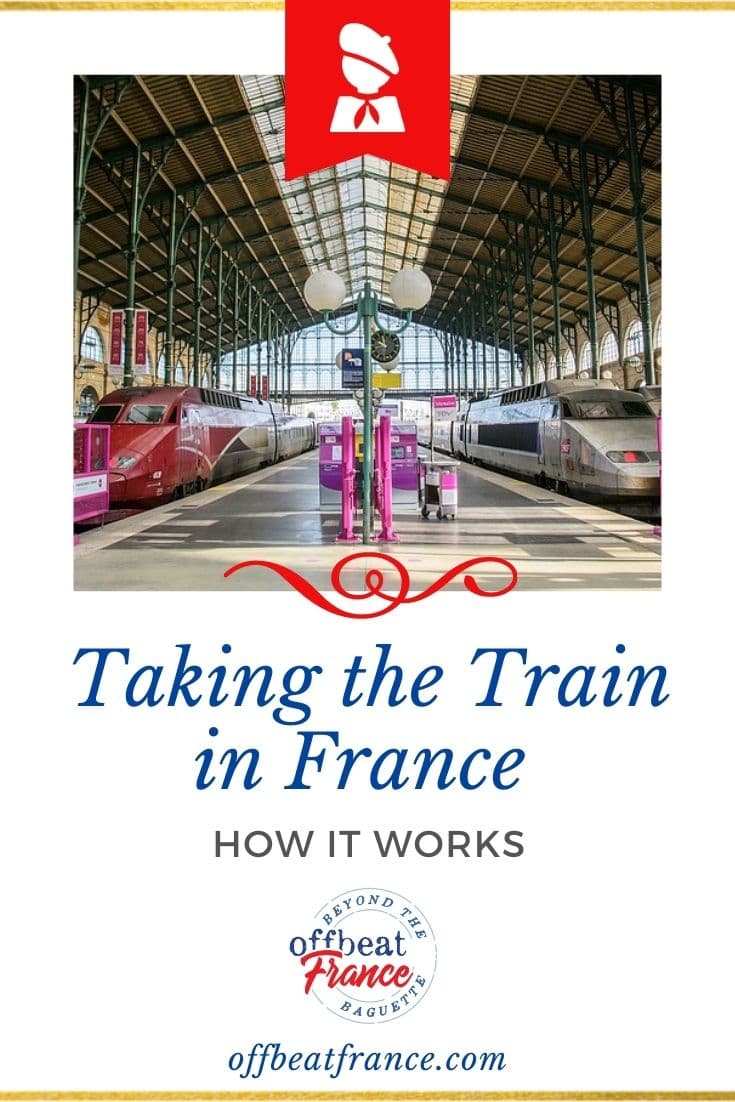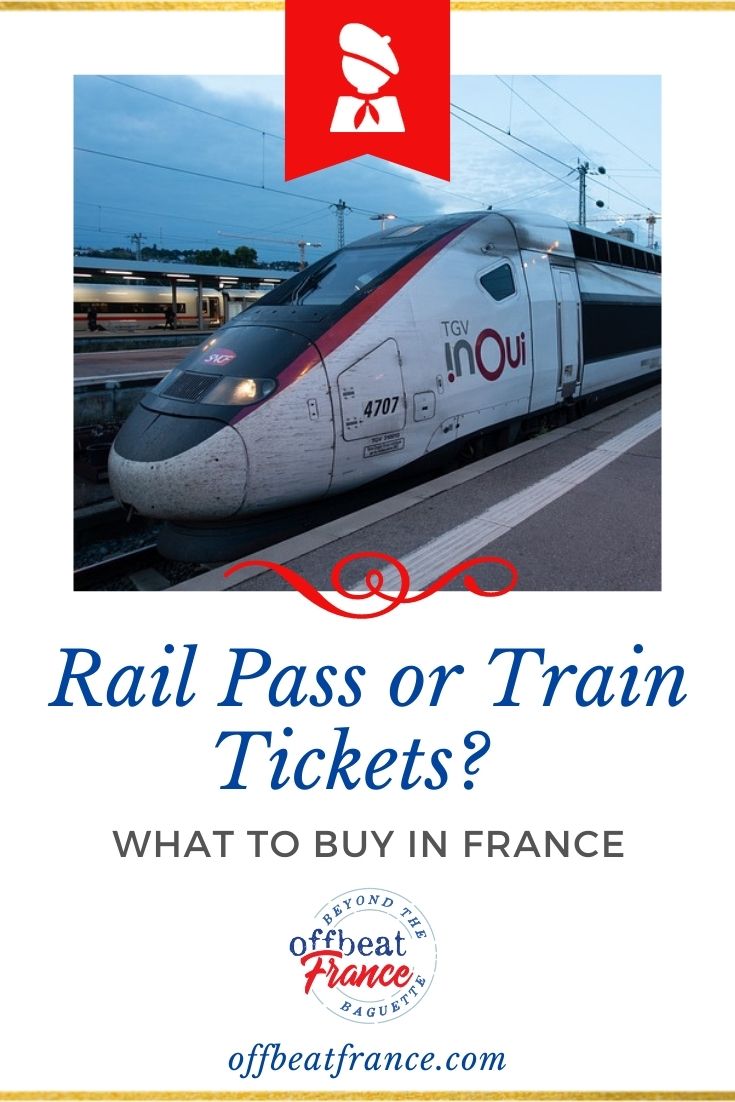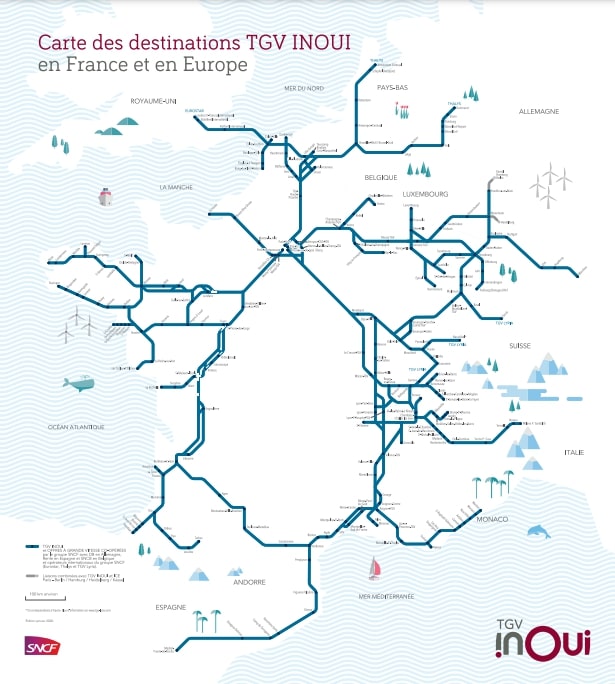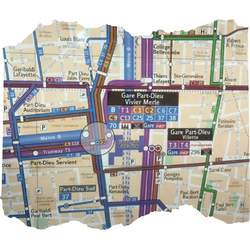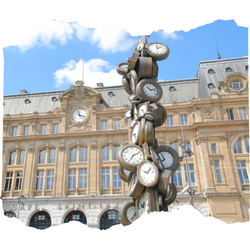Unsure about your French table manners? Click Here to download > > How to avoid these 10 food etiquette mistakes !
- Home ›
- Plan Your France Trip ›
- Train Travel
Seeing the Best of France: How To Travel France By Train
Updated 20 October 2025 by Leyla Alyanak — Parisian by birth, Lyonnaise by adoption, historian by passion
If you’re wondering exactly how to travel France by train, this practical starter guide will walk you through the essentials — from booking your first ticket to finding the best deals and understanding the system’s quirks.
France's public transport system will get you to most places in the country, from major cities to small towns, usually through fabulous scenery and often skirting exquisite villages and the odd UNESCO World Heritage site.
There are other ways to visit France, of course, and sometimes, these have advantages over the train, but that's rare.
I'm French and I live in France, and have all the different modes of transport at my fingertips, including a car. But when I can, I usually hop the train.
Why trains are the best ways to see France
Different kinds of train in France
- TGV
- Eurostar and Thalys
- Intercity trains
- TER
- Auto train
- Night trains
- Train travel with your pet in France
- International train routes
Other ways to travel in France
How to use French trains
The France railpass
Train rides from Paris
The Best Train Trips In France
What to do if there's a train strike
Book your railway tickets and passes
FAQ
NOTE: Pages on this site may contain affiliate links, which support this site. See full Privacy Policy here.
According to SNCF, France's national railway, more people now choose the train over domestic flights. Not only is the network expanding, but France has also banned most short-haul routes if trains take under 2 ½ hours.
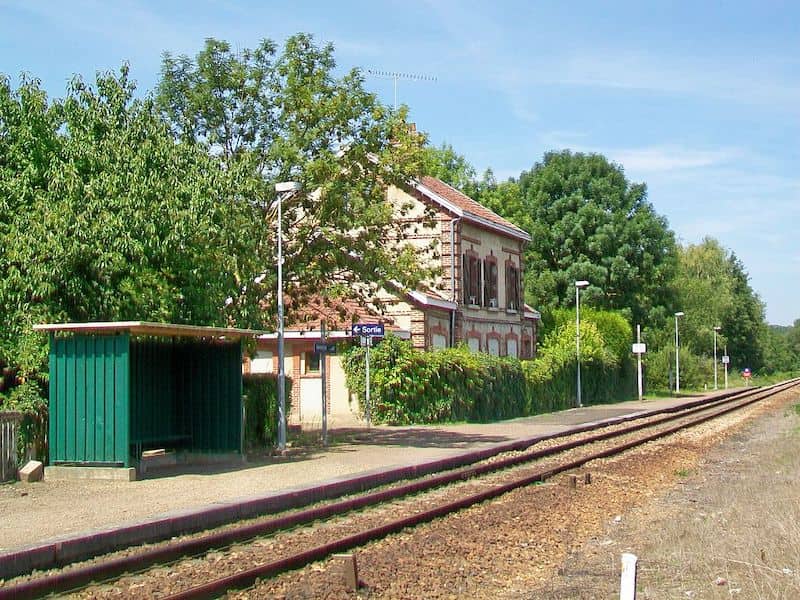 A typical rural train station in France - P.poschadel, CC BY-SA 2.0 FR, via Wikimedia Commons
A typical rural train station in France - P.poschadel, CC BY-SA 2.0 FR, via Wikimedia CommonsHOW TO BOOK TRAINS IN FRANCE (AND SAVE MONEY)
- Booking early – ideally 2-3 months ahead – can cut prices by up to half.
- To compare French train times and prices in English, Omio shows both SNCF and international services.
- If you’re planning several long-distance trips, you can get your France Rail Pass from Rail Europe. It can pay for itself within a week of travel.
- Ouigo, SNCF’s low-cost brand, also posts flash sales online, but tickets are non-refundable and must be booked digitally.
Why is train travel the best way to see France?
Traveling by train in France has many advantages over other forms of transportation.
Here are the main ones:
✓ Lower carbon emissions
✓ Comfort and relaxation, great scenery
✓ No limits on luggage weight or size
✓ You can get work done if there's wifi
✓ If you book ahead trains can be highly cost effective
✓ Train stations tend to be in the center of town, often next to the main square or market
As with everything, there are also disadvantages to rail travel in France:
✗ Not every town and village can be reached by train
✗ Trains can be full around major holidays
✗ You may have one or more connections
✗ Some areas around stations can be a bit rough, especially at night
✗ You can be subjected to train strikes (I deal with that below)
✗ You can't really choose your seat mates
✗ Trains can be expensive if you wait too long to book
If you’re new to France by train, your first trips might be a bit confusing but you’ll find it straightforward once you’ve tried it:. This guide will help put your concerns to rest.
 The beauty of rail travel in France is that you can simply relax and watch the countryside go by - Christian Ferrer, CC BY-SA 4.0, via Wikimedia Commons
The beauty of rail travel in France is that you can simply relax and watch the countryside go by - Christian Ferrer, CC BY-SA 4.0, via Wikimedia CommonsThe different kinds of French trains
Knowing the main types helps you plan the most efficient France by train itinerary — a high-speed TGV for long hops, an Intercités for regional lines, or a TER for local stops.
Until recently, most French trains were managed by the SNCF, the national railway company, with a very few private trains.
France is privatizing its railways, however, so don't be surprised if Spain's high-speed AVE or Italy's Trenitalia appear on schedules.
High-speed trains: TGV, Inoui, Ouigo
The TGV (Train à Grande Vitesse, or High-Speed Trains) are long-distance trains that travel between main destinations in France at an average speed of 320kph (nearly 200mph) along special tracks. These high-speed trains form the backbone of travel across France by train.
If you've never taken one of these, it might take you a few minutes to acclimatize, especially if they post the speed on a screen – quite impressive. The TGV whips across the French countryside passing everything in a blur of pastures and cows.
It is the queen of French trains and you should make it a point to take it at least once.
You always need to reserve your seat and buy your TGV ticket ahead of time – the earlier you buy, the cheaper the ticket. You can buy a ticket in either first or second class and if you book early and online, the price difference between the two classes might be negligible on some trips, so treat yourself...
The TGV comes in several flavors: there is a low-cost version – Ouigo, which you can book online only, and Inoui, which is a TGV brand for newer or refurbished older trains (soon, all normal TGV trains will become Inoui).
All of these are high-speed trains which you can book through Omio.
The major failing of this rail network – and of much French transportation – is that most roads lead to or through Paris. So if you want to travel from, say, Lyon in the southeast to Bordeaux in the southwest, you cannot do it directly and will usually have to go north to Paris, change stations, and head back down again.
This is changing slowly, and you may on occasion find direct trains from Lyon to a few cities, but they're very much the exception to the rule.
While the TGV train has a cafeteria car, I prefer to buy my lunch in town or at the station before boarding – the food is better and definitely cheaper.
Perhaps the one thing I dislike about TGV trains is that seats can face either forward or backward. Sometimes you can choose, but often you cannot. So if you suffer from motion sickness (as I do) and happen to be assigned a back-facing seat, you might end up spending your entire trip standing up in the restaurant car. Trains that are double-deckers make this even worse if you're upstairs, because of the ultra-bouncy suspension, but you can usually choose your floor and seat, if not your direction.
If you’re sensitive to motion, choose a downstairs seat when you book — the lower level rides smoother.
Check schedules and book your TGV here
WHY OMIO?
Throughout this guide I suggest you book your tickets through Omio. It's not the only booking agency – you can also use Trainline and SNCF, or Rail Europe (which is excellent for rail passes).
I rarely use the SNCF site because I find it's poorly built and glitchy. Trainline, on the other hand, is excellent, but I suggest Omio because 1) it comes in many languages and currencies and 2) it offers plenty of transportation options – such as buses and flights, in case you want to mix and match.
For passes, I prefer Rail Europe, because they're one of the few platforms directly connected to the Eurail/Interrail reservation system, so you can buy your pass and make your seat reservation in the same place.
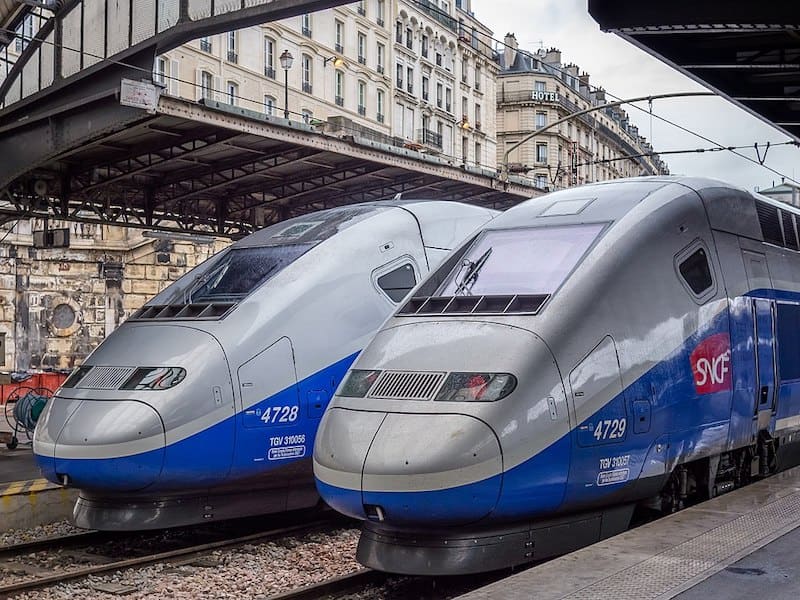 Typical TGVs, here in the Gare de l'Est in Paris - Ermell, CC BY-SA 4.0, via Wikimedia Commons
Typical TGVs, here in the Gare de l'Est in Paris - Ermell, CC BY-SA 4.0, via Wikimedia CommonsEurostar and Thalys trains
These are also high-speed trains and connect France with London, Brussels, Amsterdam, and Cologne, a smooth way to extend your France by train journey into neighboring countries.
The Eurostar is a direct train from Paris Gare du Nord to London St. Pancras. At just over 2h15, this is perfect for traveling downtown to downtown and avoiding all those pesky ferries and airport delays. Still, the cost is high and this isn't considered a bargain at all. Just a convenience.
Thalys is the train that connects you to Europe north of Paris – you can take it from Paris to Brussels, Amsterdam, Cologne, Dusseldorf, and places in-between.
You can check both Eurostar and Thalys on Omio, which also suggests connecting routes within France if you’re starting outside Paris.
Book your Eurostar and Thalys trains here
Intercity trains
The Intercités are slower than the TGVs and cover many of France's medium-sized routes, although some of these routes may also be covered by TGVs. You can decide which to take, a decision that will depend on schedules and prices.
Unlike the TGV, these trains do not require reservations. You can buy your ticket ahead of time if you don't want to bother with ticket machines or queues at the train station, but you don't have to.
They’re perfect if you’re planning a France by train itinerary that includes mid-size cities like Nancy or Bayonne.
I recommend that you buy tickets ahead of time, because the machine at the station might be broken or confusing – an online ticket bought ahead of time provides me with greater peace of mind. Also, you can't buy your ticket on board, so best be prepared.
Intercités prices tend to be stable, so you can buy closer to departure without paying more.
Check schedules and book your Intercity here
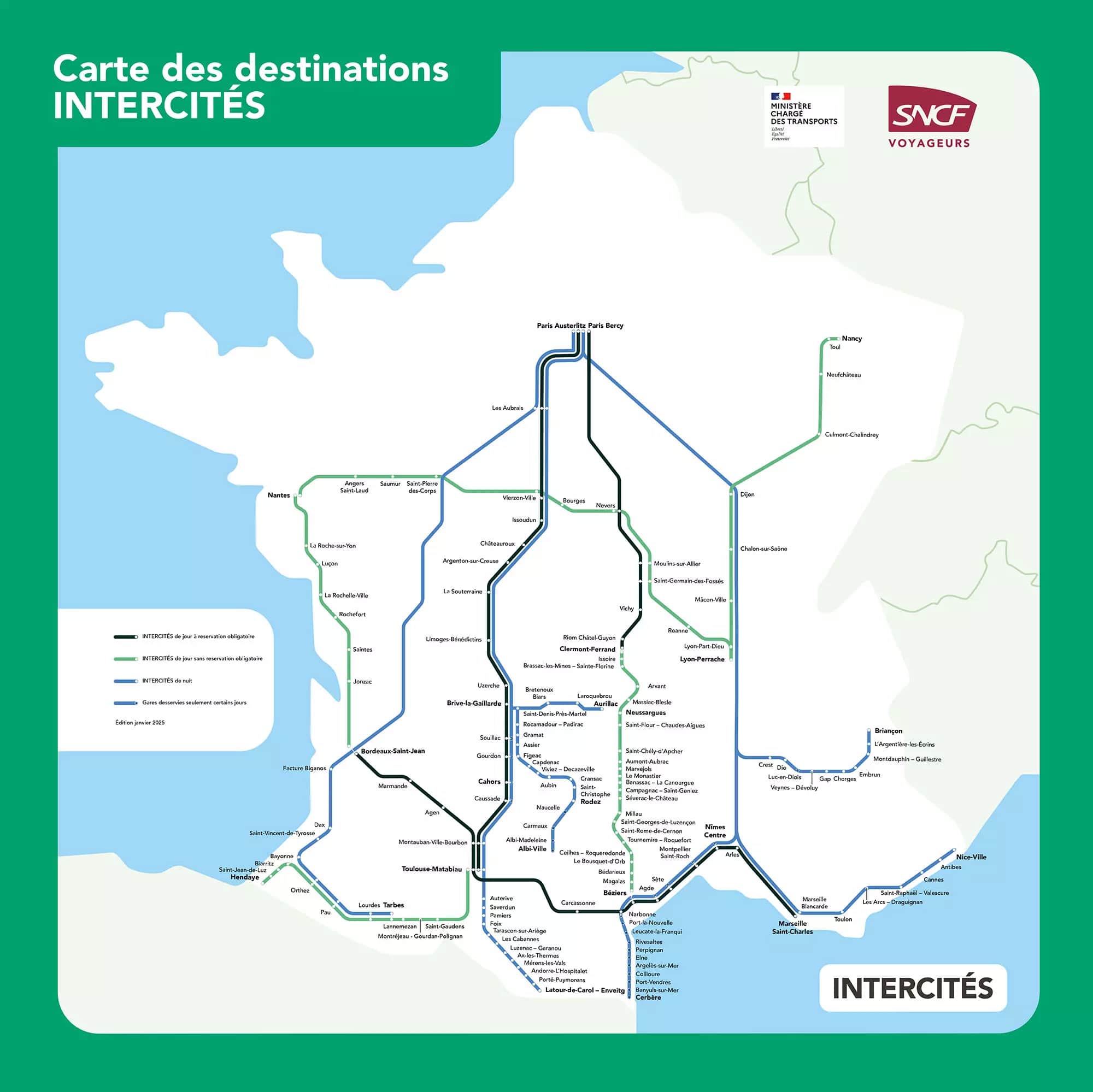
TER
These regional trains are how locals commute and how visitors reach small towns. Some of the best train routes in France — such as along the Loire or through Provence — run on TER lines.
For example, my town, Seyssel, doesn't have any high-speed trains but I can take a TGV from Paris to Valserhône and change there to a TER for a 10-minute ride.
Most often, the regional trains will wait for the TGV and Intercity if these are late. However, if your TER is late, your TGV will not wait. So if you're starting a journey on a TER and then connecting to a TGV, please give yourself ample time.
On many routes TER tickets are valid for the entire day of purchase, but refund/change rules vary by region – check the conditions on your ticket or app.
You can also buy TER tickets on Omio (coverage varies by region) or at the station.
Also, there is no seat reservation on the TER.
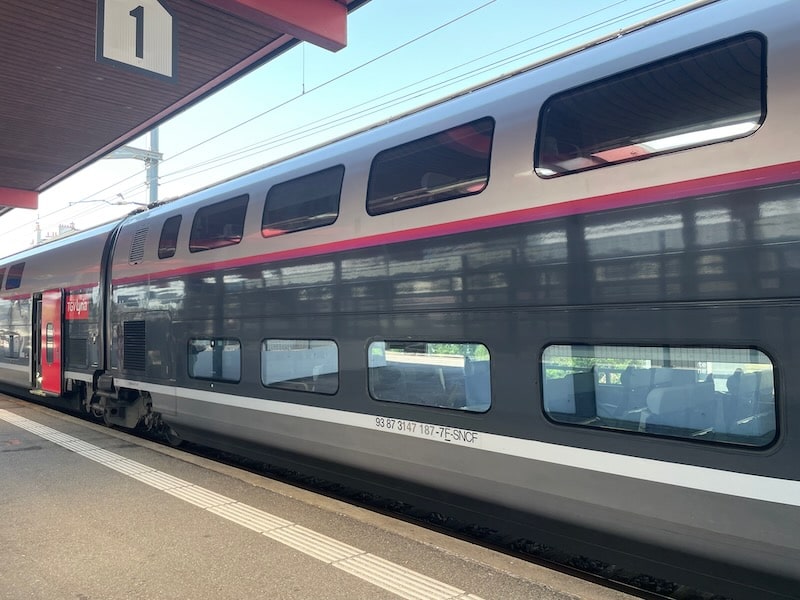 One of the many two-storied TGV Lyria trains in France
One of the many two-storied TGV Lyria trains in FranceAuto train: taking your car on French railways
You can no longer do this.
There used to be a car train from Paris to the south of France but that has been discontinued. Most people heading to the Côte d'Azur (the French Riviera) will choose to drive, or will take the train and rent a car at their destination.
However, it's worth keeping an eye out because with the resurgence of overnight trains, taking your car along might be next.
For now, the most practical option is to rent a car once you arrive — you can do this directly at most major train stations.
Click here to compare car rental prices
Night train
In my youth, before the advent of fast trains, we used to have sleeper cars and a trip was as much an adventure. I remember regularly taking the night train from Paris to Geneva, where I was attending university, and have fond memories of the people I met on these trips.
With the advent of high-speed trains and low-cost airlines, night trains began to disappear in France.
But the overnight may have been saved by the French government under President Emmanuel Macron, who has committed to returning these night trains to service.
From Paris, you can now catch an overnight train to Albi, Argelès-sur-Mer, Ax-les-Thermes, Briançon, Cannes, Lourdes, Nice and Toulouse. These services are steadily expanding, with new routes ready for Nice and Berlin, part of France’s broader move toward slow travel.
Don't expect the magnificent sleeper cars of yesteryear but you can at least lie on a bunk for the duration of the trip. Not quite the romantic night trains of our imagination... but let's call it a work in progress.
If you’d like to experience a night train, you can book directly on Omio – just filter by “night service.”
How easy is it to travel around France by train with your pet?
You can absolutely travel with your pet on the France train system and it's quite straightforward.
- Whatever its size, you'll have to pay €6-7 for your pet.
- If your pet weighs more than 6kg (usually a dog), you'll have to muzzle and leash it but it will have to travel at your feet, not on the seat beside you. I'm not sure what happens if you have a 10kg Maine Coon, though...
- If you want to reserve a ticket for your pet, you'll have to book it directly from the French railway company, SNCF. In some regions, however, a technical glitch won't allow you to book an online ticket for your pet and you'll have to get it at the station. And of course, in some stations, the machines don't work or there's no staff... In these cases, I would just board the train and stop the conductor the second you see him and explain the situation. If you wait, you will get fined. If you explain the first time s/he walks by, you "might" avoid the fine...
What are the most popular international train routes in France?
To recap, several international trains will either get you to France or take you away from the country:
- The Eurostar from France to the UK (you can also catch the Eurostar to south of France)
- The TGV Lyria, between France and Switzerland
- The Thalys to Germany, Belgium and the Netherlands
- Other highly popular routes include Italy to France trains or the Barcelona to Nice train
Book your international trains and your rail passes here.
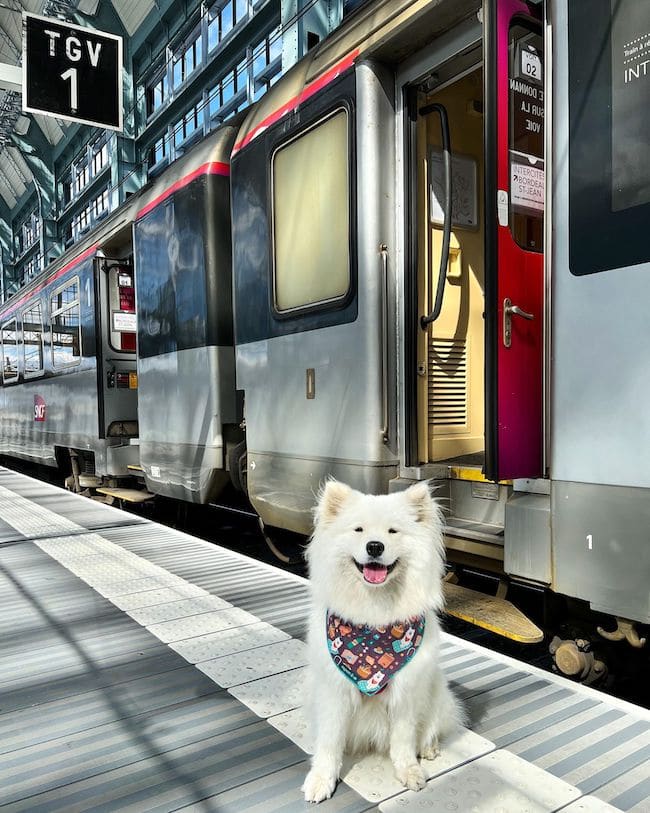 Coco the Traveling Samoyed tests the SNCF train system - and finds it agreeable! Photo Jennifer Dombrowski at Luxe Adventure Traveler
Coco the Traveling Samoyed tests the SNCF train system - and finds it agreeable! Photo Jennifer Dombrowski at Luxe Adventure TravelerOther ways to travel in France
You could travel France by car, bus, or plane, of course, but trains usually offer the best balance between comfort and cost.
Although direct trains and main lines help you travel quickly and easily, they are not always available, and sometimes, you simply have to find an alternative to the train.
Here are a few:
Pros and cons of traveling around France by car
✓ No place is out of reach, even the most remote
✓ Freedom – you don't have to stick to a timetable and can come and go
✓ You can go straight to your destination without having to connect along the way
✗ Driving in France can be... interesting
✗ You'll have to contend with parking, which is often difficult in popular places
✗ Many cities have low emission zones that restrict driving downtown
✗ Cost can be high: gasoline, tolls, parking
✗ When traffic is heavy, safety can be a concern
✗ Less relaxing for the driver than the train
✗ You could get lost and waste precious time
✗ You'll have to forget the wine, even if you're visiting a renowned château
Pros and cons of bus travel in France
✓ Like trains, bus stations are usually in the center of town
✓ Buses often go where trains do not
✓ This is often the cheapest way to travel in France
✗ Buses are far less frequent than trains
✗ You'll drive along soul-less autoroutes, usually France's least lovely sceneries
✗ Not as comfortable as the train, and sometimes not as clean
✗ Bus stations can be in even rougher neighbourhoods than train stations
✗ Buses can be a bit worrisome if you dislike the combination of high speed and narrow roads (they aren't all like this but all it takes is one)
 A number of bus companies ply France's roads, including Flixbus and Bla Bla Bus (Photo SNCF)
A number of bus companies ply France's roads, including Flixbus and Bla Bla Bus (Photo SNCF)Pros and cons of travel by air in France
✓ Low-cost airlines can cost less than the train if you book ahead
✓ East-West transport in France is poorly served and flying may be the only way to avoid doubling your distance and traveling through central Paris
✗ Your carbon footprint may be significant
✗ Airports are often far from town, a waste of time and money for extra transport
✗ Flights to your destination may be infrequent (unless you're headed to Paris)
✗ With all the extra security, a flight can take far longer than a train ride
✗ All that waiting can also be a source of frustration
✗ You're a bit of a hostage to the weather
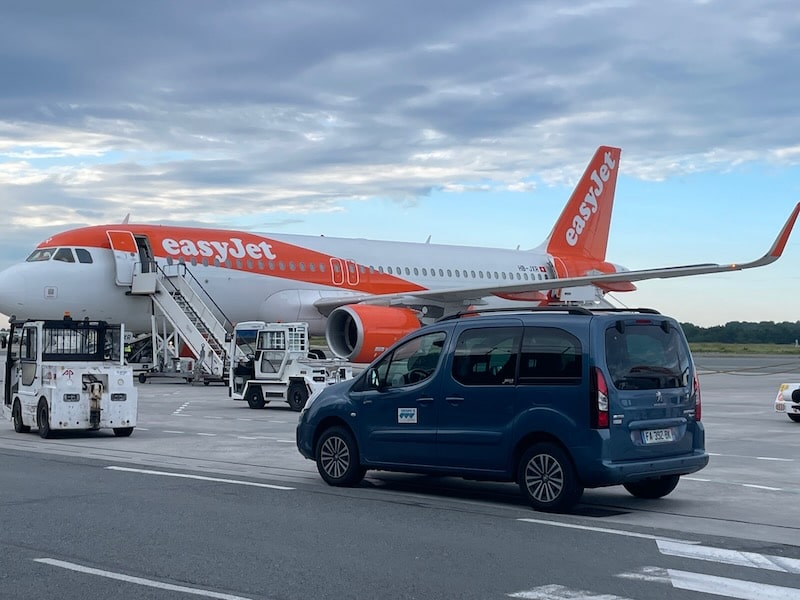 Low-cost airlines are common in France, but they are becoming increasingly regulated as the government tries to promote train travel over air travel for environmental reasons
Low-cost airlines are common in France, but they are becoming increasingly regulated as the government tries to promote train travel over air travel for environmental reasonsPros and cons of rideshares in France
✓ The cheapest way to travel
✓ Allows you to meet people and socialize during your journey
✗ You have to trust someone you don't know
✗ You have no idea of whether the driver is qualified, good or sober
✗ You have no way of knowing if the vehicle is safe or has been properly maintained
You might also like these stories!
How do you use the train in France?
The French train system isn't overly different from other European train systems and getting around France by train is relatively simple.
But, France being France, we do have a few idiosyncrasies...
- First and most important, many French cities have several train stations. Paris alone has seven. Always double-check your departure and arrival stations – they may be on opposite sides of town.
- In addition, some cities have two types of station: if the letters TGV are included in your destination's name, it might be a station designed specifically for high-speed trains, and these are often outside the city center. For example, Avignon Centre is right downtown, but Avignon TGV is 5km away. The same applies to Aix-en-Provence and Valence, each with a separate TGV station outside town.
- Larger stations have overhead departure boards (smaller stations may have them but it's not certain). Check your train number (on your ticket) because two different trains may be going to your city minutes apart – you'll need the number to identify yours.
- Train platforms appear only appear on the boards 20 minutes before departure, so don't worry.
- Always take your luggage with you wherever you go, including the bathroom. If you leave it unattended, it may soon be surrounded by armed soldiers and sniffer dogs. Not too long ago I spent more than an hour outside the Part-Dieu train station in Lyon while explosives experts blew up a backpack, probably forgotten by someone rushing to catch a train.
- If you've traveled by train in France before, you may have been warned about compostage, or stamping your ticket in the machine before boarding. Well, this is no longer the case and these machines have been phased out.
- And finally, be aware that you CANNOT buy train tickets on the train! No matter if the machine is broken and the office is closed – that's no excuse (I speak from experience). Get on your smartphone and buy it online before the train leaves the station or you'll be fined. If everything has failed and you do not have a ticket when you board, find the conductor, who must be stopped during his or her first swing through the train, and tell them your problem. It's sort of a "grace" period which may prevent a fine... but don't count on it.
These days, most tickets are digital, so you can simply show or scan the QR code on your phone as needed. Paper tickets still exist, but the old yellow compostage machines are slowly disappearing.
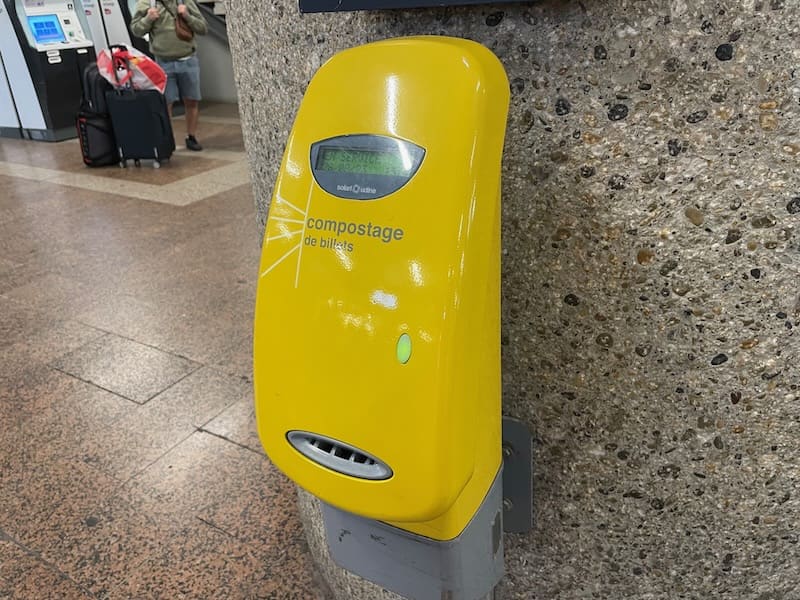 These machines were once the bane of the French railway system but they have now been phased out
These machines were once the bane of the French railway system but they have now been phased outHOW TO BUY TRAIN TICKETS IN FRANCE
- Online is easiest.
- Travel agents can also sell you tickets, as can railway stations and offices.
- You can usually buy them at train stations, either from the ticket office or the machine (if and when it's working).
Train passes in France
If you’re traveling France by train over a week or more, a pass can simplify things – and cost less. The Eurail France Pass lets you ride most national and regional trains for a specific number of days.
If you're planning on doing a lot of train travel in France, then a pass of some sort may well be cost effective. If, on the other hand, your journeys will be occasional and not necessarily predictable, a pass will probably cost you more than buying your tickets individually.
Here's what you should know about French rail passes.
- There are two distinct but relatively similar passes: Eurail if you live outside Europe, and Interail if you live within Europe (UK included, despite Brexit). Find out more about these passes here.
- Either pass allows you to travel between three and eight days during a one-month period.
- You can get a pass for several European countries if you're traveling around Europe by train but you can also get a single-country pass if you're planning a trip to France only.
- Whichever pass you choose, remember that if you take the TGV, you'll need a reservation, which costs extra. You cannot just hop on.
To recap, a rail pass is a good idea:
- if you plan many long-distance trips
- if you plan to use plenty of trains that don't require a reservation
- if you want the freedom of not having to plan (except for TGVs, you can board all other trains on a whim, as long as you have a valid ticket).
Pass holders must still reserve TGV seats (at a cost) and show their passport when checked. You can buy passes through Rail Europe or Eurail directly.
Individual train tickets are better:
- when you only plan to take the train a few times
- if there aren't many trains to your region, for example in the Ardèche or in the Luberon region of southern France
- if you plan to mostly take local trains – they are usually cheap and may cost less than a pass.
Train rides from Paris
As you can see, taking the train in France is pretty straightforward. And since there's a good chance you'll be coming across Paris at some point, here are a few extra points to know.
The one most confusing element when taking the train to or from Paris is the multitude of train stations. Here's a quick breakdown of the main ones:
- Gare d'Austerlitz: if you're headed to the southwest
- Gare de l'Est: for eastern France, Germany and northern Switzerland
- Gare de Lyon: south towards Lyon and onward to the Riviera, to Spain and to western Switzerland
- Gare Montparnasse: western France
- Gare du Nord: northern France and Belgium, the Netherlands and parts of Germany – and the Eurostar for the London to France train
- Gare Saint-Lazare: Normandy
- Paris Bercy Bourgogne – Pays d'Auvergne: central France
If you’re not sure which station to head for, type your destination into Omio – it will display the correct departure point automatically.
Bear in mind that these distinctions are more general than exact, so do check your ticket carefully to make sure you head for the correct station. Getting to them isn't complicated because they're all on either commuter lines or rapid subway lines.
Also bear in mind that if you're changing trains in Paris, you may have to cross town to do so. Sometimes not, but it pays to check.
Several brilliant day trips by train depart from Paris — to Chartres, Dijon or Rouen, for example.
The best trips by train around France
Organizing a France by train itinerary can be a fun experience. We have a very dense railway network combined with a huge variety of landscapes, so getting on the train will often yield something stupendous.
For example, taking the train from Marseille to Nice is a delight. Not only do you avoid the dense road traffic (especially in summer), but you'll be treated to a delightful sequence of cliffs, beaches, turquoise seas, marinas, yachts, glorious flowered gardens... the journey is a vacation in itself.
Sometimes, a banal everyday journey can be stunning. If you're traveling from Geneva, Switzerland towards Aix-les-Bains, as I have often done, you'll discover two distinct visual gems: the gorges and aqueduct over the Rhône as you speed across the Swiss-French border, and the beautiful shore of the Lac du Bourget, where the train line was built hugging the water.
Here's a wonderful list of some of the most beautiful French train journeys.
What if there's a France train strike?
Ah yes, the dreaded train strikes.
Strikes are rarely surprise events in France – they’re usually announced days ahead. According to SNCF, at least one in two TGV trains runs even during major strikes.
Strikes a fact of life but they don't have to be as problematic as they sound. You are not powerless in the face of striking trains: there is plenty you can do to minimize your headaches if you travel by train in France, even if workers do decide to walk off the job during your holidays.
Find out about strikes ahead of time
France does not usually have "wildcat strikes", or strikes without warning. They are planned, announced, and efforts are made to minimize disruption.
- First, check the SNCF website page that lists service disruptions. You can also use the SNCF Connect app for real-time updates or check Omio, which flags cancellations on its booking pages.
- Check out cestlagreve.fr, which carries notices of all declared upcoming strikes, in all sectors (in French only).
- Scour local media looking for these words: "grève + sncf + month and year". This should yield some information, which you can then translate through Google or other translation methods.
- Check TheLocal.fr. Although this is a subscription newspaper, it often has free coverage for public service items.
If all else fails, France’s bus network (Flixbus, BlaBlaBus) can often get you to your destination — just book early as they fill quickly during strikes.
Get information at the station
If your train is on strike, go directly to the station, at least if it is a large one. The information counter should be able to direct you to an alternate train or point you towards a bus, if one has been put in place to replace the train.
Unfortunately, small stations will often not have information counters.
Rebook or get a refund
Most tickets are refundable, unless you've bought the absolute cheapest. Even then, you might be able to get something if you show up at the train station before your train is supposed to leave.
If you cannot get a refund, you might be able to rebook to a later train, because even during a strike, there is some train service, although it is often minimal.
These days, the SNCF has a Twitter (X) account so you can usually contact them @sncfconnect or @sncfvoyageurs.
Have a Plan B
The most important thing you can do is be flexible, either to catch another train or to find an alternative.
- I mentioned the bus, but if the SNCF hasn't put one on, you can still check regular bus services for yourself.
- You can also rent a car (here's a comparison engine) to get to your destination. There is an extra cost but you can usually drop off the car in a different city than the one in which you picked it up.
- Check out Bla Bla Car, the ride-sharing service. It's rare you'll find something at the last minute but if you're desperate...
DEALS AND DISCOUNTS
France by train can be surprisingly affordable if you know where to look.
- SNCF releases its cheapest fares three months in advance, so set a reminder to book early.
- Watch for Prem’s fares on TGV INOUI/Intercités — they’re limited and cheapest when sales open.
- The Avantage Card (Jeune/Senior/Famille) gives ~30% off and caps prices on many TGV routes — useful if you’ll take more than 2–3 long trips.
- Look for Ouigo trains for low-cost routes and the Avantage Card (for youth, senior, or family) to save 30%.
- Omio lets you filter by “cheapest” to find the best deal, and Rail Europe offers pass discounts for multi-day travel.
FAQ
Is it easy to travel around France by train?
Is it easy to travel around France by train?
Yes. France’s rail network covers almost every city and many towns, although it's sparse in villages. Trains run frequently and tickets can be booked online in English through Omio.
How far in advance should I book French train tickets?
How far in advance should I book French train tickets?
You can often get a ticket three months ahead of time, so book early to get the cheaper TGV/Intercity rates. As for the TER, no need to book. Just buy your ticket and then hop on.
What is the most beautiful train ride in France?
What is the most beautiful train ride in France?
There are many! Some of the loveliest include Marseille-Nice along the Mediterranean, the Train Jaune in the Pyrenees, and the InterLoire through vineyards.
Do French trains have wifi and charging ports?
Do French trains have wifi and charging ports?
Long distance trains usually do, but not at every seat, and wifi can be patchy. Sockets also don't always work... to be safe, bring a power bank.
Can I travel France by train with a Eurail Pass?
Can I travel France by train with a Eurail Pass?
Absolutely. Just remember that if you're taking the TGV, you'll have to reserve your seat.
Are French trains on time?
Are French trains on time?
They usually are. According to SNCF, 90% of TGVs are on time. But there are no guarantees so give yourself plenty of time if you're planning to connect.
Before you go...
Taking the train in France is usually a joy, for all the reasons I mentioned earlier. It's not perfect, but train journeys are the ones I look forward to the most.
If after all this you've decided you'd rather not, read this piece on driving in France because, as is the case with everything else, we're just a "little bit" different!
Top header photo credit Florian Pépellin CC BY-SA 3.0 via Wikimedia Commons
Did you enjoy this article? I'd love if you shared it!
